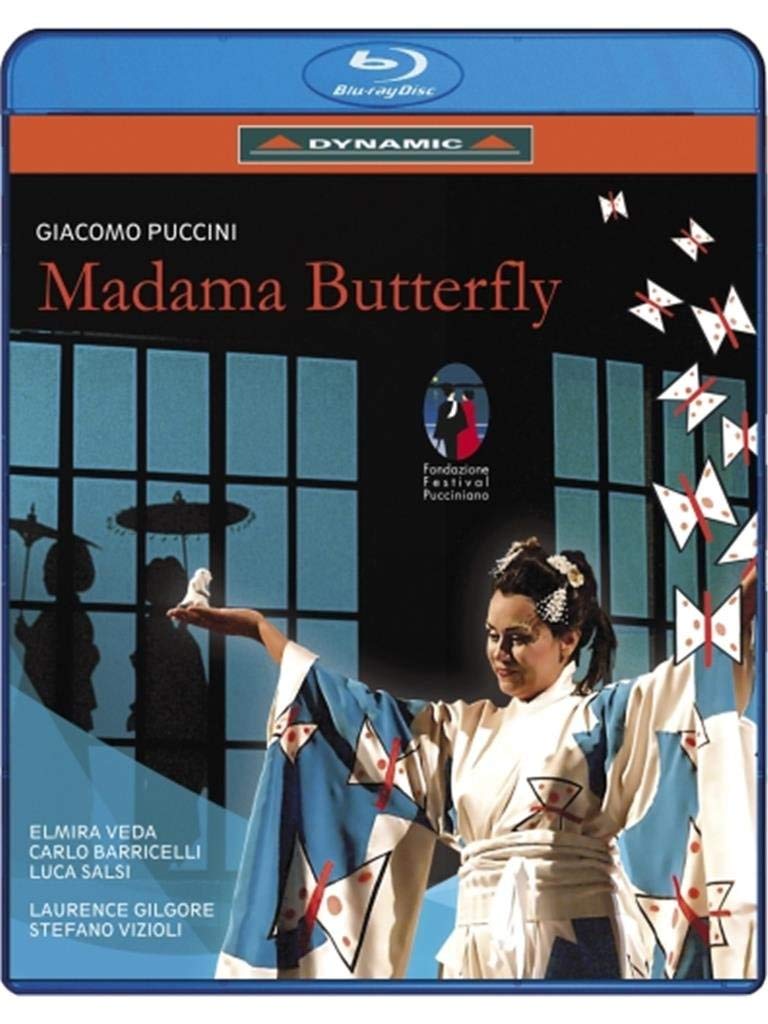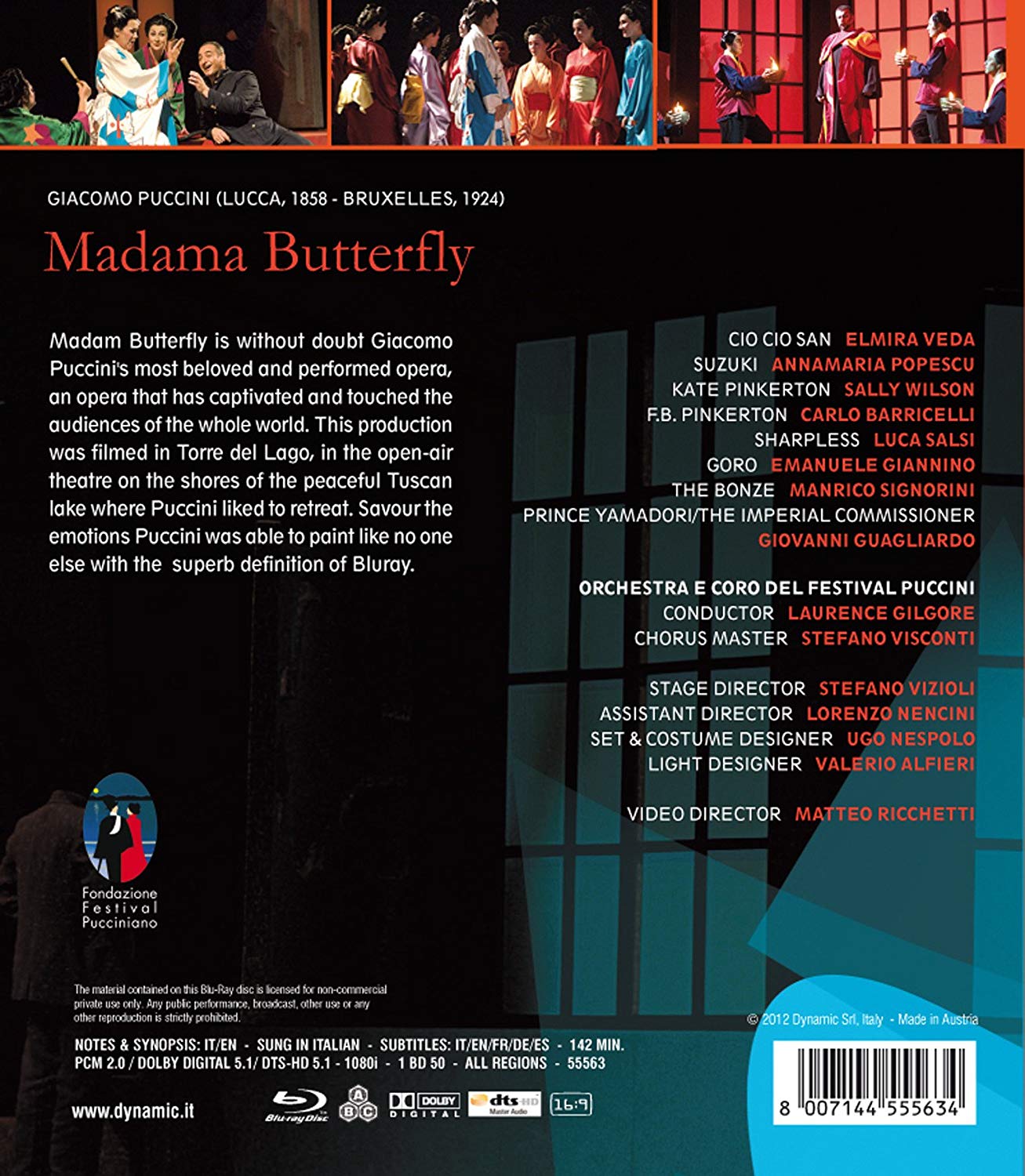

Puccini Madama Butterfly opera to a libretto by Giuseppe Giacosa and Luigi Illica. Directed 2007 by Stefano Vizioli at the Puccini Festival, Torre del Lago Puccini. Stars Elmira Veda (Cio Cio San or Madama Butterfly), Annamaria Popescu Suzuki), Sally Wilson (Kate Pinkerton), Carlo Barricelli (B.F. Pinkerton), Luca Salsi (Sharpless), Emanuele Giannino (Goro), Manrico Signorini (The Bonze), and Giovanni Guagliardo (Prince Yamadori / The Imperial Commissioner). Laurence Gilgore conducts the Puccini Festival Orchestra and Chorus (Chorus Master Stefano Visconti). Assistant stage direction by Lorenzo Nencini; set and costume design by Ugo Nespolo; light design by Valerio Alfieri. Directed for TV by Matteo Ricchetti; sound recording by Mateo Costa; editing and mixing by Rino Trasi. Sung in Italian. Released 2011, disc has 5.1 dts-HD Master Audio sound. Grade: D+
This title just barely qualifies for inclusion on this website because it appears all the full-stage shots were recorded, as you can see in the opening 2 screenshots, with an SD camera:
This show was staged in July outdoors by the Fondazione Festival Pucciniano. This kind of venue is popular with audiences because they don't have to dress up. But if, as here, the slack discipline of the outdoor festival also extends to the production itself, the HD camera will reveal every flaw and compromise. For example, I think most regular opera houses in Italy would have nicer costumes than what we see here:
And if the stars are to be dressed this poorly, there's certainly no budget to pay for Butterfly's wedding retinue in all their finery. But there's a solution for this: shadows!
This outdoor venue was tricky to light. The whole stage suffers generally from low light; and there are numerous dark areas, hot spots, and inexplicable shadows on the faces and bodies of the singers. This handicaped the camera crews, who in 2007 were probably not working with the best gear available. Lack of light contributes to fuzzy resolution throughout the show even when HD cameras were used. Colors look grayed out and dingy. Next are a few shots illustrating these lighting problems.
Cio Cio San arrives with family and friends for her wedding. But since the guests all arrived as silhouttes, director Vizioli has little choice but to cover the whole group in one large shadow:
At least above you can see half of Miss Butterfly's face. Below she delicately explains the plight that brings her and her group to the threshold of love with a foreign sailor arranged by a marriage broker. This is our introduction to Cio Cio San as a person, and it gives the acting singer an opportunity to win us over to her side immediately. But how would this be possible if we can't see her face?
And consider the plight of poor Kate Pinkerton. Trapped in a foreign county, she has hours before learned that she will be a mother sooner than she expected—and that of a child fathered by a man who has just declared himself to be a coward. The actress singing Kate has just a few moments to show the audience her anguish—she is almost as big a victim here as Butterfly. But how can Kate do that if she is black-listed by the director as we see here:
Can the musicians overcome the visual misery of this show? The members of the orchestra must all be able to play MB by heart. I get the impression they are bored; to me the performance has little zest or life. Or maybe it's for technical reasons that the recording on my system sounds more like an CD rather than a modern surround recording.
The singers are capable and do have the ability to do one thing that's important in the outdoor venue: sing loud. I have to turn down the volume on my AVR when Carlo Barricelli opens his mouth as Pinkerton. Often he looks like he is putting out every decibel possibly available to him. Of course, he is also miked. So should I blame Barricelli or the engineer at the mixing board? Elmira Veda is also able to sing all the notes at terrific volume. This might make her a prize performer for an outdoor production. But in the home theater, her mighty exertions at singing limit her ability to pay attention to acting.
Finally the stage directing is weak throughout this production. A particularly horrid example is the direction of Veda as Cio Cio San during the Humming Chorus (end of Act II) and the Introduction to Act III (sometimes called the Chorus of Sailors). For the entire Humming Chorus, Vizioli keeps his singers hidden. Poor Veda has to stand on stage and act out longing and despair. Then Veda continues to stand there looking tragic throughout the 7-minute Chorus of Sailors. This totals 10 minutes of Elmira alone and silent on stage, which seems like a geological era when stuck in a fast-moving Puccini opera. (Contrast this to the treatment by Pier Luigi Pizzi in the C Major HDVD of Madama Butterfly. Pizzi has a solemn chorus in mysterious veils march slowly by for the Humming Chorus. Then for the Introduction to Act III he has two beautiful young ballet dancers show us in a mini-pas de deux what Cio Cio San and Pinkerton are supposed to look like.)
What to make of this disappointing disc? Opera lovers interested in HDVD were delighted when Dynamic entered the market with Blu-ray discs. Dynamic has, I understand, a huge vault of Italian opera treasures. But, alas, if this MB is any indicator, it would appear that few of the Dynamic legacy titles will be good enough to publish in HDVD.
I don't want to be snide about this production. Most every town in Italy seems to have it's own opera house and/or festival. Local singers have plenty of work; the public gets its opera fix at reasonable prices. The fans don't expect stars from foreign countries or Zefferelli-style sets; they are happy with the singers they know and moderate production values. So you might enjoy this title if you have an sincere interest in Italian singers and opera productions.
But if you just want a nice MB to enjoy in HDVD, this title likely will not satisfy you. A much better (although by no means perfect) outdoor production at an Italian festival would be the Pier Luigi Pizzi version published by C Major. To get a really good MB, it may be necessary to find a production at one of the big opera houses.
OK, I hope I've avoided being snide. I hope my rosy depiction above of Italian opera today is accurate. But I suspect it is not. I've been in Italy enough to know that no nation on earth has a richer cultural heritage to be proud of than the Italians. But are they making the necessary investments to maintain that heritage? Or have they turned their history and their opera system into a giant tourist trap designing to drain the franchise dry? I personally think that Giacomo Puccini would be much alarmed and asking the same question if he were allowed to watch this Blu-ray video produced by a foundation using his name.
OR











